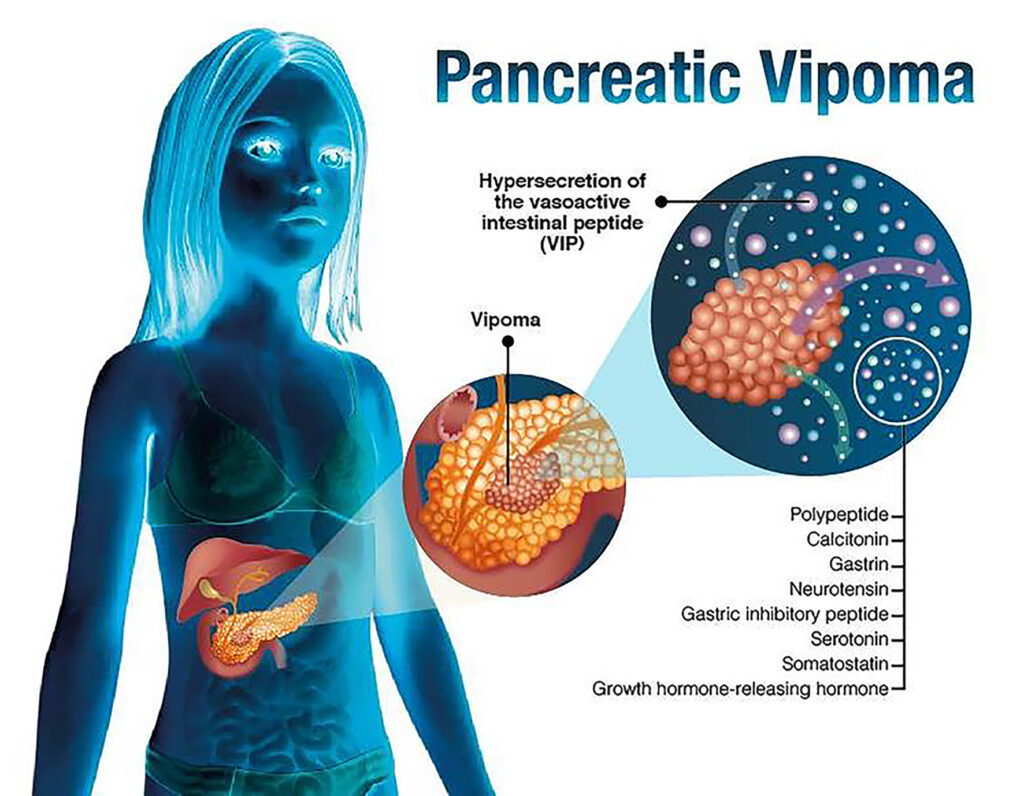Vasoactive intestinal peptide (VIP)-secreting tumors, commonly referred to as VIPomas, are rare pancreatic neuroendocrine tumors that produce excessive amounts of VIP. This results in profound secretory diarrhea, hypokalemia, and achlorhydria, collectively known as WDHA (watery diarrhea, hypokalemia, and achlorhydria) or Verner-Morrison syndrome. Although VIPomas are rare, understanding their clinical presentation, diagnosis, and treatment is crucial for effective management.

Pathophysiology of VIP-Secreting Tumors
VIPomas originate predominantly in the pancreas but may also arise from sympathetic ganglia, adrenal glands, or the intestines. These tumors autonomously secrete VIP, a neuropeptide that:
- Stimulates intestinal chloride and water secretion, leading to profuse watery diarrhea.
- Inhibits gastric acid secretion, causing achlorhydria.
- Promotes potassium loss, resulting in hypokalemia.
- Induces vasodilation and hyperglycemia.
The excessive VIP secretion disrupts fluid and electrolyte balance, leading to severe dehydration and metabolic disturbances.
Clinical Presentation
Patients with VIPoma typically present with chronic, large-volume, non-bloody, watery diarrhea exceeding 700 mL/day, often persisting despite fasting. Other key symptoms include:
- Severe dehydration
- Muscle weakness and cramps (due to hypokalemia)
- Weight loss
- Flushing
- Abdominal pain (occasionally)
- Hyperglycemia (due to VIP’s effects on glucose metabolism)
Diagnosis
Laboratory Tests
- Serum VIP Levels: Elevated (>75 pg/mL confirms diagnosis)
- Electrolytes: Low potassium, metabolic acidosis, and hypercalcemia
- Fasting Plasma Glucose: Possible hyperglycemia
- Stool Studies: High sodium and potassium concentrations
Imaging Studies
- CT or MRI of the abdomen: Detects primary tumors and metastases
- Somatostatin receptor imaging (e.g., Ga-68 DOTATATE PET/CT): Identifies tumor spread
- Endoscopic ultrasound (EUS): Locates small pancreatic tumors
Differential Diagnosis
- Zollinger-Ellison Syndrome (ZES)
- Carcinoid syndrome
- Chronic infections (e.g., cholera, Giardia)
- Inflammatory bowel disease (IBD)
- Laxative abuse
Treatment and Management
Acute Management
- Fluid and Electrolyte Replacement
- IV saline with potassium supplementation
- Correction of acid-base imbalance
- Somatostatin Analog Therapy
- Octreotide or Lanreotide: Inhibits VIP secretion, reducing diarrhea
Definitive Treatment
- Surgical Resection
- Preferred treatment for localized tumors
- Whipple procedure may be required for pancreatic head tumors
- Targeted Therapies and Chemotherapy
- Sunitinib, Everolimus for metastatic VIPomas
- Peptide receptor radionuclide therapy (PRRT) for somatostatin receptor-positive tumors
Prognosis
- Localized VIPomas: 5-year survival rate ~95% after surgical resection
- Metastatic disease: Median survival 4–5 years with therapy

